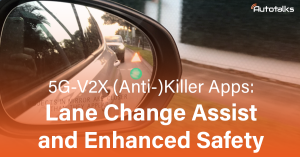The world of V2X and road safety technology is wide, and includes a lot of technical terms, complex technologies, and variety of uses.
We know all of this can be really confusing and lead to a lot of questions, the answers of which are scattered all over the web and are usually way too long and technical.
That’s why we decided to gather all this information in one place and create the ultimate V2X frequently asked questions, a go-to page to get clear and concise answers to all your V2X-related questions.
V2X
Q: What is V2X?
A: V2X (Vehicle-to-Everything) technology refers to the direct communication between vehicles and other road users, such as vehicles, micromobility, pedestrians, and infrastructure. It allows vehicles to share information about their speed, location, and direction, as well as receive real-time information about road conditions. This enables vehicles to mitigate a collision even with hidden risks.
Q: What is V2X used for?
A: V2X (Vehicle-to-Everything) technology is mainly used for increasing safety and preventing accidents on the road. Additionally, V2X can also be used for other applications such as emergency services, improving traffic flow, and tolling. These are some of the main applications of V2X technology, but new usages are being explored as the technology continues to evolve.
Q: What are the types of V2X communication?
A: The main types of V2X communication are V2V (Vehicle-to-Vehicle), V2I (Vehicle-to-Infrastructure), , V2B (Vehicle-to-Bike), V2M (Vehicle-to-Motorcycle) and V2P (Vehicle-to-Pedestrian).
Q: What is 5G V2X?
A: 5G V2X is a technology that uses the latest New Radio (NR) for V2X (Vehicle-to-Everything) communication. 5G V2X provides a higher level of safety and efficiency on the road, with faster and more reliable communication. Those enable new features such as cooperative perception and cooperative maneuvering.
Q: What Is C-V2X?
A: C-V2X (Cellular Vehicle-to-Everything) is a technology that allows both direct and network communication between vehicles and other vehicles, infrastructure, and devices. It uses cellular communication technologies (such as LTE and 5G) to transmit data, such as location, speed, direction, and road conditions, between vehicles and other devices. C-V2X direct communication does not require a base station to operate.
Q: What is the impact of V2X?
A: The impact of V2X (Vehicle-to-Everything) is that it significantly improves transportation safety and mobility, by mitigating accidents that no other sensor can, increasing efficiency, reducing environmental impact, and enabling more autonomous vehicles. It is a life-saving technology that protects all road users.
Q: When was V2X invented?
A: V2X (Vehicle-to-Everything) technology has been in development for several decades. The concept of vehicles communicating with each other and with infrastructure dates to the late 1990s and early 2000s, when research and development in this area began to accelerate. The first V2X systems were primarily focused on Vehicle-to-Vehicle (V2V) communication targeting safety applications such as collision avoidance. Subsequently, the research and development expanded to include other types of V2X communication such as Vehicle-to-Infrastructure (V2I) and Vehicle-to-Pedestrian (V2P) communication.
Q: How many cars have V2X?
A: It is difficult to give an exact number of cars that have V2X (Vehicle-to-Everything) technology, as thousands of vehicles are deployed every month, and the deployment rate is growing. Analysts estimated that there were about 0.7 million cars on the roads equipped with V2X capabilities at the end of 2020, with that number expected to grow to 35.1 million by 2025.
Q: Which cars have V2X?
A: Several car manufacturers have announced plans to integrate V2X technology into their vehicles. Volkswagen equips the latest Golf model and all ID electric vehicles. Toyota offers V2X units in Japan. More models will be launched soon, while availability may vary depending on different regions.
Q: What is the range of V2X?
A: The range of V2X is at least 600 meters on the highway and 200 meters in an urban intersection. In some cases, the range can be extended depending on the specific environment and the vehicle’s antenna location.
Q: What are the benefits of V2X?
A: The main benefits of V2X include:
– Improved safety by providing real-time information about other vehicles and hazards.
– Increased efficiency by speed harmonization which reduces traffic congestion.
– Reduced emissions by optimizing traffic flow and communication with traffic lights and other infrastructure.
– Enhanced comfort for drivers by providing information about parking and weather conditions.
Q: How does C-V2X help autonomous cars?
A: C-V2X (Cellular Vehicle-to-Everything) technology can help autonomous vehicles by increasing the quality of the driving decision by complementing and adding redundancy to the other vehicular sensors. This allows them to drive more safely and efficiently. Additionally, C-V2X can enable communication between autonomous vehicles and other road users in situations such as merging vehicles, pedestrians crossing, and traffic lights. It enables the coordination of movements and reduces the risk of collisions.
Q: What is V2X for micromobility?
A: V2X for micromobility enhances communication between small personal transportation devices, like electric scooter and bicycles, and other road users. It solves the prime reason of micromobility accidents: “failure to see”. V2X makes drivers aware of micromobilty even if they are hidden behind the corner or obstructed by other vehicles.
C-V2X
Q: What does C-V2X stand for?
A: C-V2X stands for “Cellular vehicle-to-everything”. It is a wireless communication technology that enables direct communication between vehicles, as well as between vehicles and infrastructure such as traffic lights and road signs. C-V2X technology is designed to enhance road safety, traffic efficiency and the overall driving experience. C-V2X is the only vehicular sensor that can detect hidden road users. It is based on the 3GPP cellular communications standards.
Q: How does C-V2X work?
A: C-V2X uses cellular communications technology to enable direct communication between vehicles, as well as between vehicles and infrastructure such as traffic lights and road signs. It uses a similar cellular technology used in mobile phones and other devices, but it is designed specifically for short distance communication use in vehicles. It is independent of the mobile cellular network, using a dedicated communication channel in the 5.9 GHz band.
DSRC
Q: What does DSRC stand for?
A: DSRC stands for “Dedicated Short-Range Communications”. It is a wireless communication technology that enables vehicles to communicate with each other and other road users directly. DSRC is rooted in WiFi, using a specification called IEEE802.11p.
General
Q: Can cars communicate with each other?
A: Yes, cars can communicate with each other through a technology called V2V (vehicle-to-vehicle) communication. V2V communication allows vehicles to directly communicate with each other, sending and receiving information such as speed, location, and braking status. This can help improve road safety by allowing vehicles to warn drivers of hazards and potential collisions. V2V communication can be enabled through technologies such as DSRC (Dedicated Short-Range Communications) and C-V2X (Cellular Vehicle-to-Everything), which are specifically designed for use in vehicles.
Q: How does 5G technology work in vehicles?
A: 5G technology can be used in vehicles to enhance the communication capabilities of vehicles and improve the overall driving experience. 5G is designed to support much faster data speeds and lower latency than previous generations of cellular technologies. 5G C-V2X is an example of the implementation of 5G New Radio (NR) in a vehicle safety communication technology.
Q: How does V2V work?
A: V2V communication typically works by having a vehicle constantly broadcast its own information such as speed, location, trajectory, and braking status to other vehicles within range. Other vehicles in the area can then receive this information and use it to make real-time decisions about their own driving. For example, if a vehicle ahead of you suddenly brakes, your vehicle will receive this information and can alert you about the potential hazard, or even automatically apply the brakes.
Q: Is car-to-car communication mandatory in all vehicles?
A: Car-to-car (C2C) communication is not mandatory in all vehicles. Instead, carmakers are incentivized by global New Car Assessment Programs (NCAP) which grants safety points for V2X usage. In Europe, local hazard warnings will be graded from 2023, basic V2X use-cases from 2026 and advanced from 2029. In China, basic V2X use-cases will be graded from 2025, and advanced from 2028. With that, carmakers offering V2X will lead the car safety charts.
V2I
Q: What is vehicle-to-infrastructure (V2I) communication?
A: Vehicle-to-infrastructure (V2I) communication refers to the communication between a vehicle and the infrastructure, such as traffic lights and road signs. This communication allows for the exchange of information that can improve the safety and efficiency of the transportation system. Examples of V2I communication include the use of road side units, which transmit information about road and weather hazards to an upcoming vehicle, and traffic signal preemption, in which a vehicle can request that a traffic signal change to accommodate its arrival.
Q: What are the uses of V2I?
A: V2I can be used for various purposes like traffic management, safety, environmental benefits, public transit, and emergency services prioritization and to support connected and automated vehicles. For example, V2I can be used to improve the response time of emergency services by reducing waits at a traffic light, and prevent congestions and accidents by enabling road works warnings.
Q: What are the benefits of V2I communication?
A: There are many benefits to V2I, such as:
– Emergency vehicles can arrive faster to save lives, safely passing through red lights.
– A smart intersection can detect a pedestrian crossing the road or other road users that can impose a danger, and alert vehicles approaching the intersection.
– Public transportation can be prioritized when approaching the traffic light.
Overall, V2I can improve safety, reduce traffic congestion, enhance mobility, and be integrated with other systems to provide a better driving experience and cost savings.








